5 Benefits of a Data Catalog: Why You Need One in 2024
Share this article
A data catalog improves data discovery, management, and governance. It centralizes metadata, enabling teams to find, access, and trust data faster. This enhances decision-making, ensures compliance, and fosters collaboration across an organization by providing a single source of truth for data assets.
See How Atlan Simplifies Data Cataloging – Start Product Tour
The 5 main benefits of a data catalog are: #
- Data catalogs help in the improvement of employee productivity and quality of life
- Data catalogs help in optimized data governance and business efficiency
- Data catalogs ensure consistency in data quality
- Data catalogs ensure regulatory compliance
- Data catalogs help in reducing spending and unnecessary costs
Let’s explore and understand these benefits of data catalog in detail in this article.
Table of contents #
- 5 main benefits of a data catalog
- Why do you need a data catalog?
- What is a data catalog?
- Benefits of a data catalog in detail
- Data Catalog users also asked these questions
- Atlan Data Catalog Benefits
- Benefits of data catalog: Related reads
Why do you need a data catalog? #
Data teams need data catalog to better control and understanding of their data assets to draw valuable insights. That’s where a data catalog can help.
When you walk into a library, you’ll see shelves upon shelves of books. Still, you will notice the ease with which a librarian helps you find and access the book you need — down to the exact shelf position.
That’s because libraries depend on physical and online catalogs to organize their information resources. The data universe faces a similar struggle, and data managers are waking up to the need for data catalogs as part of their data management and governance efforts.
Like libraries, organizations are dealing with more data than ever before — we created 64.2 zettabytes (i.e., 64.2 trillion gigabytes) of data in 2020, according to IDC.
For example, marketing teams track every user’s interaction across hundreds of digital touchpoints — website, social media, and other apps. Hospitals maintain heaps of sensitive patient information — detailed health records, insurance details, social security numbers, and billing information.
However, most of that data is raw and unstructured, gathered from various sources. Therefore, before we extract value, that data must undergo several transformations. Without these transformations, your data is not just useless but also vulnerable to security breaches and compliance risks.
Data teams need data catalog to better control and understanding of their data assets to draw valuable insights. That’s where a data catalog can help.
What is a data catalog? #
A data catalog is an organized inventory of an organization’s data assets, similar to the physical and online catalogs that libraries use.
Data Catalog helps technical and non-technical users find and access information quickly.
A data catalog has several modules or tools to:
- Manage metadata (i.e., data about data)
- Enable rapid search and discovery with adequate context
- Support access control
- Enable a robust data governance
One of the essential elements of a data catalog is metadata. Metadata provides crucial context about data with information, such as:
- Data type
- Data classification
- Origins
- Current location
- Creation date
- Last updated on
- Change logs or revision history
- Owner and editors
That’s why any data catalog worth its salt has to ensure active metadata management.
To know more about active metadata and it’s management, check out this article.
Benefits of a data catalog in detail #
As mentioned earlier, a data catalog is one of the pillars necessary in modern data management. So, if you’ve been asking yourself, “why are data catalogs essential?”, then here are five reasons outlining the benefits of data catalogs.
Benefit #1 — Improve employee productivity and quality of life #
For businesses to achieve their mission of being data-driven, they must set up the systems and processes that make it easier for data citizens to access the required data as fast as possible. However, according to IBM research, businesses spend 70% of their time looking for their data and only 30% using the data.
Even when they get access, there’s not enough visibility into the transformations that data sets undergo. So, situations like the one below are commonplace.
- Data analyst Jim needs sales and marketing data to determine which products performed best in the previous quarter. Jim finds the relevant data but has to clean and organize it before using it. It takes Jim a week to do that.
- One week later, data scientist Pam is looking for the same data to input the sales information into the accounting department’s data. Pam has no idea Jim worked on the same data the previous week, so she repeats the entire data preparation process, making Jim’s work redundant.
While Jim and Pam work in the same organization, they end up repeating the same tasks, wasting time and effort that could have been spent more efficiently elsewhere.
Data catalogs eliminate the need for repetitive tasks and work done in silos by providing a central source of data for everyone. So, with a data catalog, Pam would see the transformations a certain data set has undergone and would have just used the version Jim had used.
A central repository with Google-like search powered by NLP (natural language programming) ensures that your teams spend less time looking for data and more time extracting value from it.
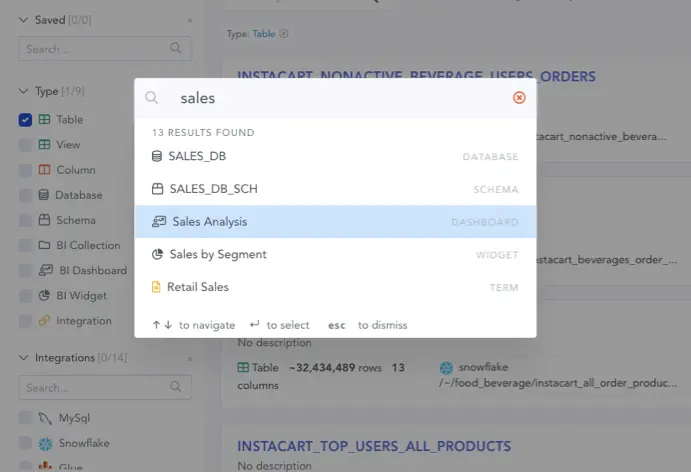
Google like search. Image by Atlan.
Meanwhile, the detailed lineage maps and revision histories — updated in real-time — guarantee that your teams don’t duplicate efforts or work in silos.
Data catalogs also help you go through all the context you need at a glance with:
- Comprehensive business glossaries and descriptions
- Auto-generated data profiles
- Quick quality reports
- Capabilities such as chats, in-line annotations, discussions, and data sharing with a link
As a result, your teams collaborate efficiently, spend time on strategic tasks (rather than operational tasks like cleaning data) and finish their projects sooner.
By offering a unified platform for data, data catalogs improve collaboration across departments. This is especially useful in hybrid and remote work setups, where 35% of workers report increased productivity due to better access to shared resources and clearer workflows
Benefit #2 — Optimize data governance and business efficiency #
Data governance involves managing data availability, integrity, usability, and security based on internal data standards and policies.
Data catalogs show what data assets an organization has and their locations. So, you know exactly where your data comes from and how it’s being stored.
As mentioned earlier, data catalogs track lineage or movement of data across an organization, which provides a reliable audit trail throughout that asset’s life cycle. This documents all the transformations a data asset has undergone and also the impact (if any) on related data sets.
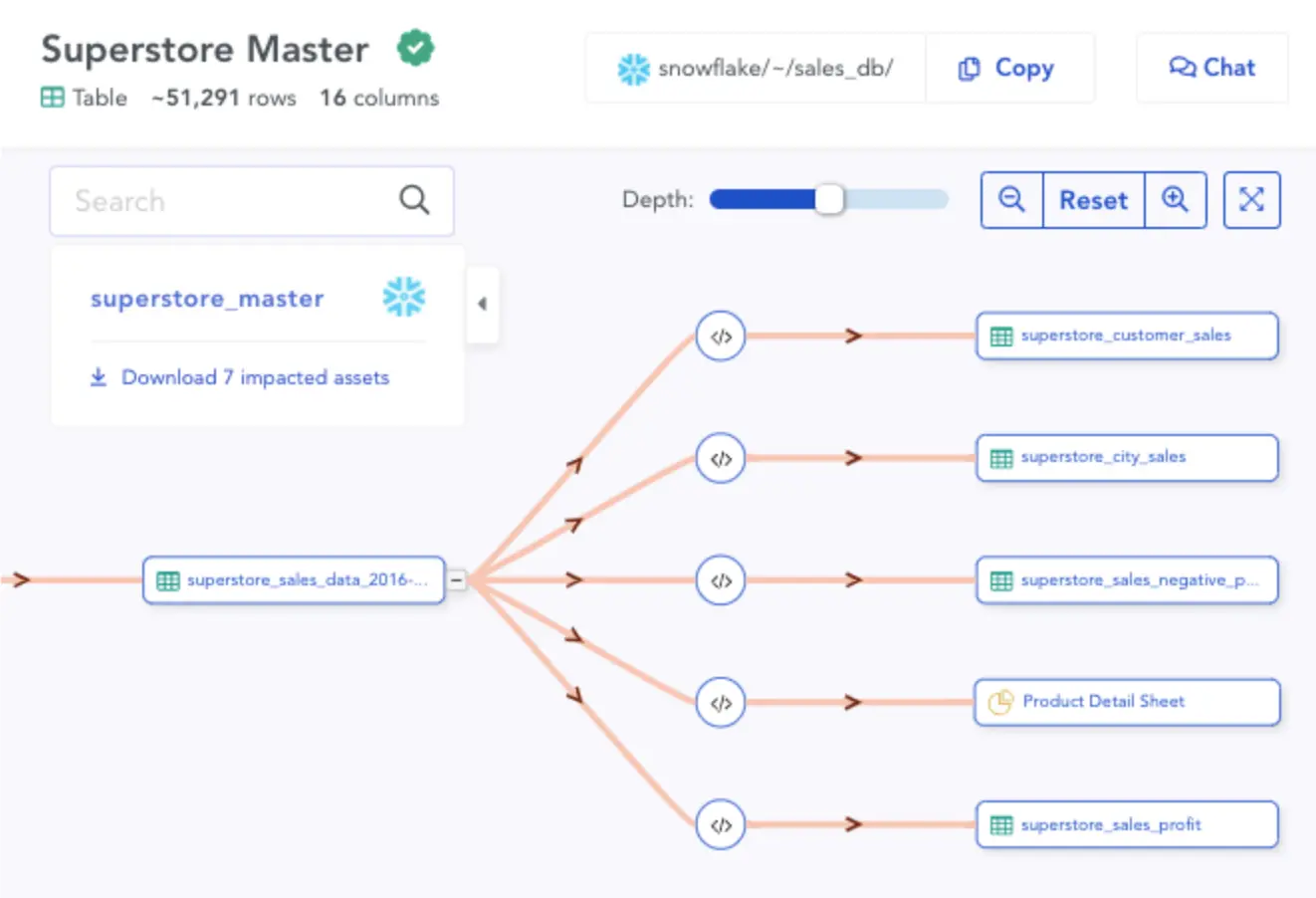
Automated Lineage via SQL Parsing. Image by Atlan.
Data lineage also helps identify and mitigate the data risks. For example, you can set up alerts for anomalies in data sets with modern data catalogs. So, when you get an alert about outliers or inconsistencies in data, you can trace the data’s lifecycle to investigate the incident, weed out the root cause and fix it right away.
Modern data catalogs also enable granular access controls — role-based and asset-level permissions. So, each user can only access the data they need, which minimizes the risk of data leaks or breaches. According to a report from the Ponemon Institute, 71% of employees have access to data they should not see. With granular controls, you can regulate access, preserve data integrity and privacy, and democratize data.
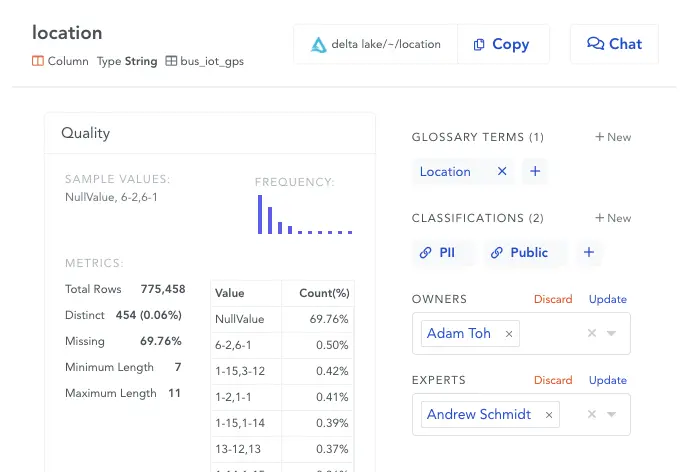
Visibility of data quality. Image by Atlan.
Benefit #3 — Ensure consistent data quality #
Data quality is essential for you to trust your data. However, data quality remains a major problem for most businesses.
One reason this has remained the case is the need for manual processes, which take a long time and are riddled with errors. A robust, automated modern data catalog automatically:
- Scans source systems for new data, which means your data is always up-to-date
- Generates data profiles automatically
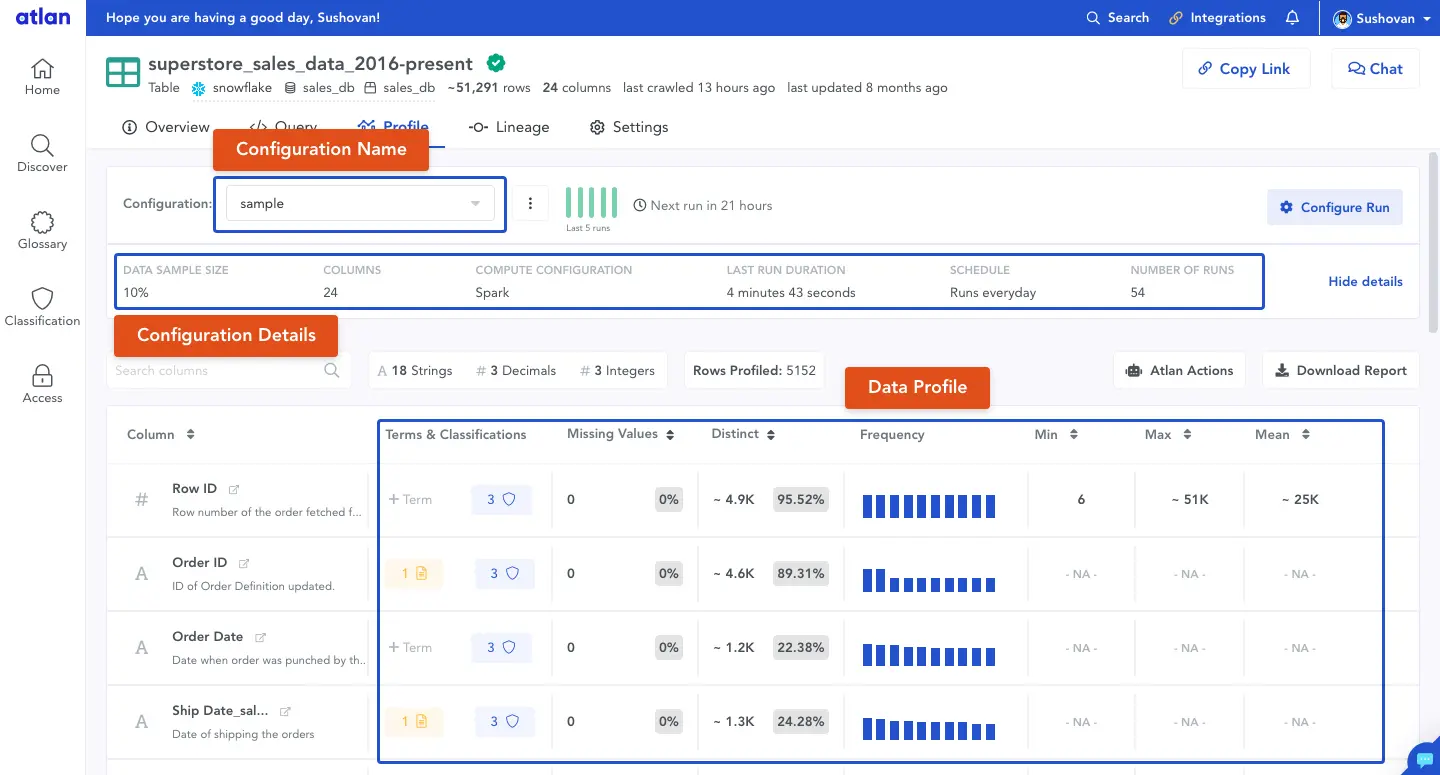
Auto-generated data profile. Image by Atlan.
- Classifies data, especially sensitive PII data
- Detects duplicates, anomalies, and inconsistencies in data with scheduled data quality checks
By constantly tracking data quality, a modern data catalog becomes the single, credible source of truth for a business.
Benefit #4 — Ensure regulatory compliance #
The regulatory environment will continue to become more stringent with rapid digitization. Gartner predicts that 75% of the world will be covered under some kind of privacy law with built-in subject rights requests and consent by 2023.
That’s why data catalogs can be great data management tools for ensuring regulatory compliance. Here’s how that would work.
Modern data catalogs let you add tags to your metadata so that you can classify sensitive data automatically and regulate access to these assets with greater scrutiny.
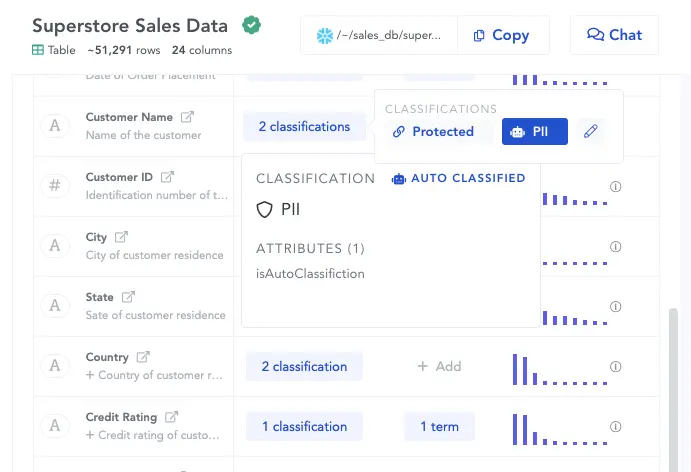
Auto-classified PII data. Image by Atlan.
So, your compliance officers can continuously track and monitor sensitive data to ensure that your data meets the regulatory requirements of standards such as CCPA, HIPAA, PCI DSS, and GDPR.
You can also address any irregularities or problems with sensitive data. For example, if sensitive data is located where it shouldn’t be, those in charge of compliance can address the issue by removing that data from the location and revisiting its access policies.
Benefit #5 — Reduce spending and unnecessary costs #
Data catalogs optimize costs in two ways:
- The money and operating costs that you save from productivity gains
- The hefty fines you avoid by complying with regulatory standards
Referring back to one of our earlier examples, Jim and Pam would be more efficient with their time and deliver business insights faster. The productivity gains have a direct impact on minimizing operating costs.
Also as mentioned earlier, data catalogs are crucial in ensuring good governance and compliance with regulatory standards. So, you minimize exposing your data to risks such as data breaches and avoid getting hefty fines for non-compliance with data privacy laws.
For instance, the GDPR fines hit almost 1 billion euros in Q3 of 2021 — nearly 20 times higher than the fines from Q1 and Q2 combined. Better governance programs with modern data catalogs can help minimize such instances.
According to Mckinsey, one global bank saved $400 million annually by consolidating over 600 data repositories into 40 domains, enabled by a more centralized data management approach facilitated by data catalogs.
Data Catalog users also asked these questions #
What is a data catalog and why do organizations need it? #
A data catalog is an inventory of an organization’s data assets that helps users find and access information quickly. It enables effective data management and improves governance by providing structure, especially as data volumes grow.
How does a data catalog improve productivity? #
A data catalog boosts employee productivity by enabling faster data discovery and reducing search time, allowing employees to focus on higher-value tasks and improving overall efficiency.
How does a data catalog support data governance? #
Data catalogs optimize data governance by organizing data, ensuring accessibility, and applying access controls. This maintains data integrity and supports compliance with regulations.
How can a data catalog reduce operational costs? #
A data catalog reduces redundancies, ensures consistency, and minimizes errors, helping organizations cut unnecessary costs and streamline data processes, improving operational efficiency.
How does a data catalog help with regulatory compliance? #
A data catalog ensures that sensitive data is properly classified, managed, and secured. This minimizes compliance risks and helps organizations meet regulatory requirements by providing clear data lineage and control over data access.
Atlan Data Catalog Benefits #
Atlan provides a comprehensive data catalog that enables organizations to discover, understand, and govern their data assets effectively.
It automates metadata management tasks, such as data discovery and lineage tracking, through features like its no-code connectors and AI-powered metadata enrichment.
This allows users to access rich context on data assets through features like the “Asset 360” profiles. Atlan’s platform offers personalized experiences for diverse user personas, empowering both technical and non-technical users to collaborate and leverage data insights.
Book your personalized demo today to find out how Atlan data catalog can help your organization in achieving regulatory compliances.
Benefits of data catalog: Related reads #
- Data Catalog: What It Is & How It Drives Business Value
- What Is a Metadata Catalog? - Basics & Use Cases
- Modern Data Catalog: What They Are, How They’ve Changed, Where They’re Going
- Open Source Data Catalog - List of 6 Popular Tools to Consider in 2024
- 5 Main Benefits of Data Catalog & Why Do You Need It?
- Enterprise Data Catalogs: Attributes, Capabilities, Use Cases & Business Value
- The Top 11 Data Catalog Use Cases with Examples
- 15 Essential Features of Data Catalogs To Look For in 2024
- Data Catalog vs. Data Warehouse: Differences, and How They Work Together?
- Snowflake Data Catalog: Importance, Benefits, Native Capabilities & Evaluation Guide
- Data Catalog vs. Data Lineage: Differences, Use Cases, and Evolution of Available Solutions
- Data Catalogs in 2024: Features, Business Value, Use Cases
- AI Data Catalog: Exploring the Possibilities That Artificial Intelligence Brings to Your Metadata Applications & Data Interactions
- Amundsen Data Catalog: Understanding Architecture, Features, Ways to Install & More
- Machine Learning Data Catalog: Evolution, Benefits, Business Impacts and Use Cases in 2024
- 7 Data Catalog Capabilities That Can Unlock Business Value for Modern Enterprises
- Data Catalog Architecture: Insights into Key Components, Integrations, and Open Source Examples
- Data Catalog Market: Current State and Top Trends in 2024
- Build vs. Buy Data Catalog: What Should Factor Into Your Decision Making?
- How to Set Up a Data Catalog for Snowflake? (2024 Guide)
- Data Catalog Pricing: Understanding What You’re Paying For
- Data Catalog Comparison: 6 Fundamental Factors to Consider
- Alation Data Catalog: Is it Right for Your Modern Business Needs?
- Collibra Data Catalog: Is It a Viable Option for Businesses Navigating the Evolving Data Landscape?
- Informatica Data Catalog Pricing: Estimate the Total Cost of Ownership
- Informatica Data Catalog Alternatives? 6 Reasons Why Top Data Teams Prefer Atlan
- Data Catalog Implementation Plan: 10 Steps to Follow, Common Roadblocks & Solutions
- Data Catalog Demo 101: What to Expect, Questions to Ask, and More
- Data Mesh Catalog: Manage Federated Domains, Curate Data Products, and Unlock Your Data Mesh
- Best Data Catalog: How to Find a Tool That Grows With Your Business
- How to Build a Data Catalog: An 8-Step Guide to Get You Started
- The Forrester Wave™: Enterprise Data Catalogs, Q3 2024 | Available Now
- How to Pick the Best Enterprise Data Catalog? Experts Recommend These 11 Key Criteria for Your Evaluation Checklist
- Collibra Pricing: Will It Deliver a Return on Investment?
- Data Lineage Tools: Critical Features, Use Cases & Innovations
- OpenMetadata vs. DataHub: Compare Architecture, Capabilities, Integrations & More
- Automated Data Catalog: What Is It and How Does It Simplify Metadata Management, Data Lineage, Governance, and More
- Data Mesh Setup and Implementation - An Ultimate Guide
- What is Active Metadata? Your 101 Guide
Photo by Element5 Digital from Pexels
Share this article









